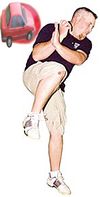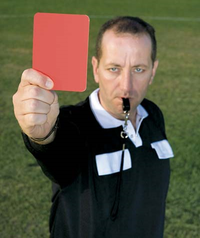Schnallball

|
“Either that player goes, or I do.”
Schnallball is a complicated German game involving up to 75 balls, a referee, 16-530 players, and (invariably) one small duck.
Invention[edit | edit source]
Schnallball was invented in 1861 by a German farmer by the name of Albrecht Interstein. Having suffered major losses to his flocks of oxen and flamingoes, he had nothing better to do than freeze to death. While doing this, he created the hideously complex rules of Schnallball that are still in use today. He inscribed the rules onto the walls of his house before dying.
Rules[edit | edit source]
The rules of Schnallball are many and there are, at last count, 1,503 different variations. The most played include the 'Original' or 'Ready Salted' rules, the Atlantean Equestrian rules and the Guildford Green and Brown rules. All of these rules specify any changes to the manner of play depending on conditions such as:
- The referee's mood.
- The number of balls in play
- The volume and chapter that the game is in.
- Atmospheric pressure
- Wind direction
It is rumored that there are a certain set of conditions that, if fulfilled, would end the game of Schnallball forever; however, since an up-to-date copy of the rules (if printed out) would take up approximately the same volume as the Pacific Ocean, it is impossible to find rules unless using the index.
Play[edit | edit source]
Start of Play[edit | edit source]
A game of Schnallball begins with one team throwing their choice of the ball at the other team. The other team must intercept it and often choose to begin the Zig-zag Dodge attack (right). The player with the ball attempts to reach bases 2.9, 39.7 and 6.3 in order while dodging the opposition's attacks. They then shoot for goal, ending the first phase. On the other hand, if the attacker is hit, one of the defending team runs to grab the bat and may attempt a ---wallapalooza---. This consists of him hitting the ball as hard as possible at the other team's captain.
Second Offense[edit | edit source]
The attacking team is then allowed another attempt. The favored method for this is the Flight of the Dancing Fish maneuver - which consists of the entire team attacking their opponents armed with traffic cones.
Second Half[edit | edit source]
At this point, the defenders retaliate, usually with a complex strategy that, to the untrained eye, might appear to be a game of piggy-in-the-middle. The opposition generally counter this by appealing (see Appeals)
Final Quatrain[edit | edit source]
The use of this part of the match is unknown, as the winner is decided by the flip of a coin at the end of the third half. Of course, if the referee does not like the result, he may arbitrarily change it. However, it is during this part of the match that most injuries occur, so it seems they know something we don't.
Balls[edit | edit source]
Please read on.
|
Many different balls are used in Schnallball depending on the choices of the referee and team captains, as well as the scores. These include, but are not limited to, the following:
- Cricket Ball
- Thrown in by the referee and crowd at any time. If a player is hit, he must stand still for 2.43 seconds.
- Tennis Ball
- As the Cricket Ball, but for junior games.
- Bowling Ball
- Generally used in the less friendly games.
- Golf Ball
- Used to score most points, as only one goalkeeper (James "Suicidal" Jones) has been found that is willing to jump in front of a well-hit golf ball.
- Snow Ball
- Rather impractical, but useful for distraction.
- Christmas Ball
- Has been reported to be a little unwieldy.
- Eye Ball
- Rather slimy and slightly illegal.
Regulatory Bodies[edit | edit source]
Regulatory bodies for Schnallball include the Honourable Jumping Badgers and the ASS (American Schnallball Society). Many of these regulatory bodies eventually become dedicated to taking care of the ever-increasing number of ex-referees who have been driven insane by the complexity of the rules.
Appeals[edit | edit source]
A player may appeal at any time by running to the referee and holding their hands in the standard 'Appeal' formation (both hands pointing upwards with elbows out). The referee then makes a decision and communicates this to the players by waving his hands in front of him (if negative) or through a blend of dance and kazoo-playing (if positive}.
See also[edit | edit source]


